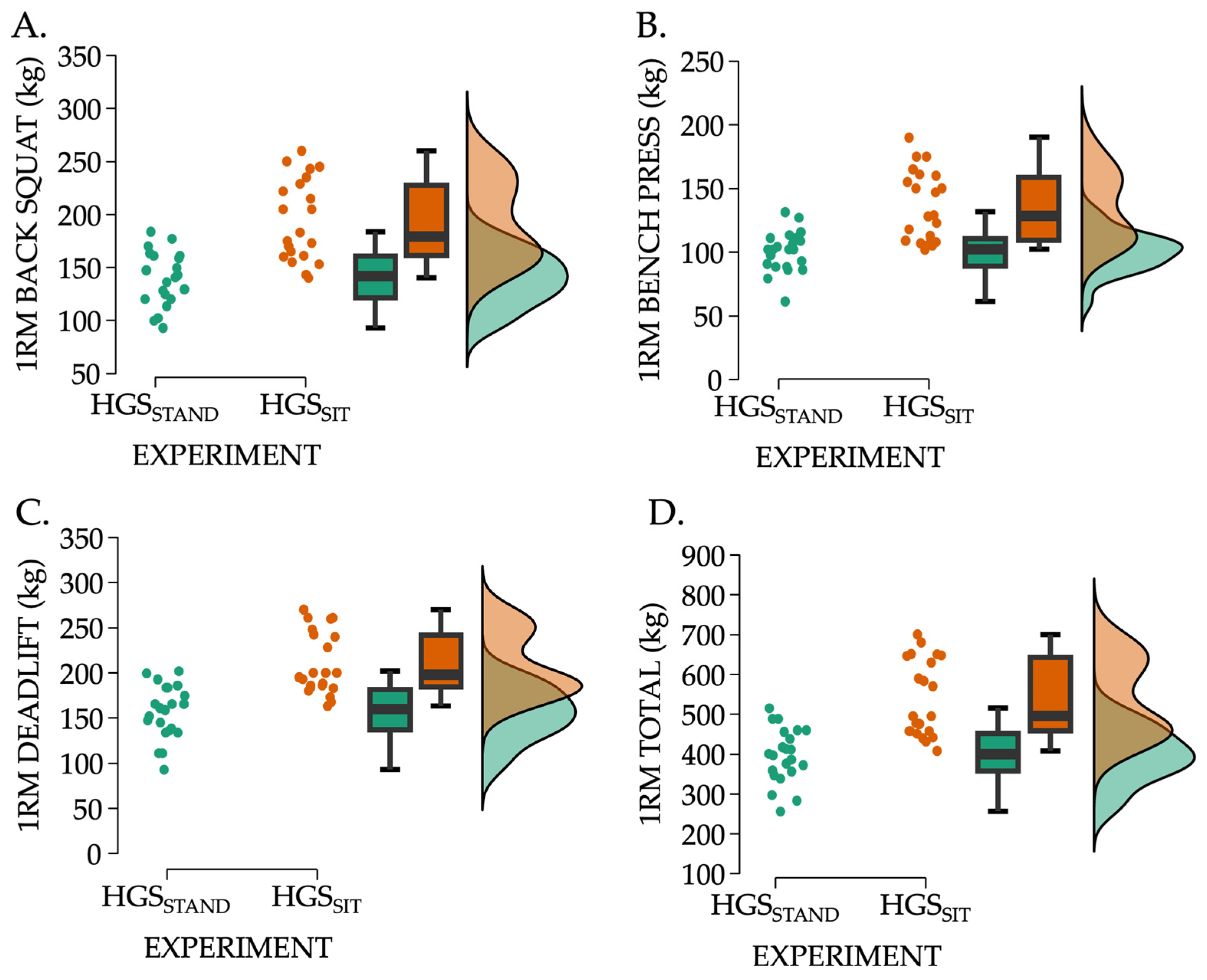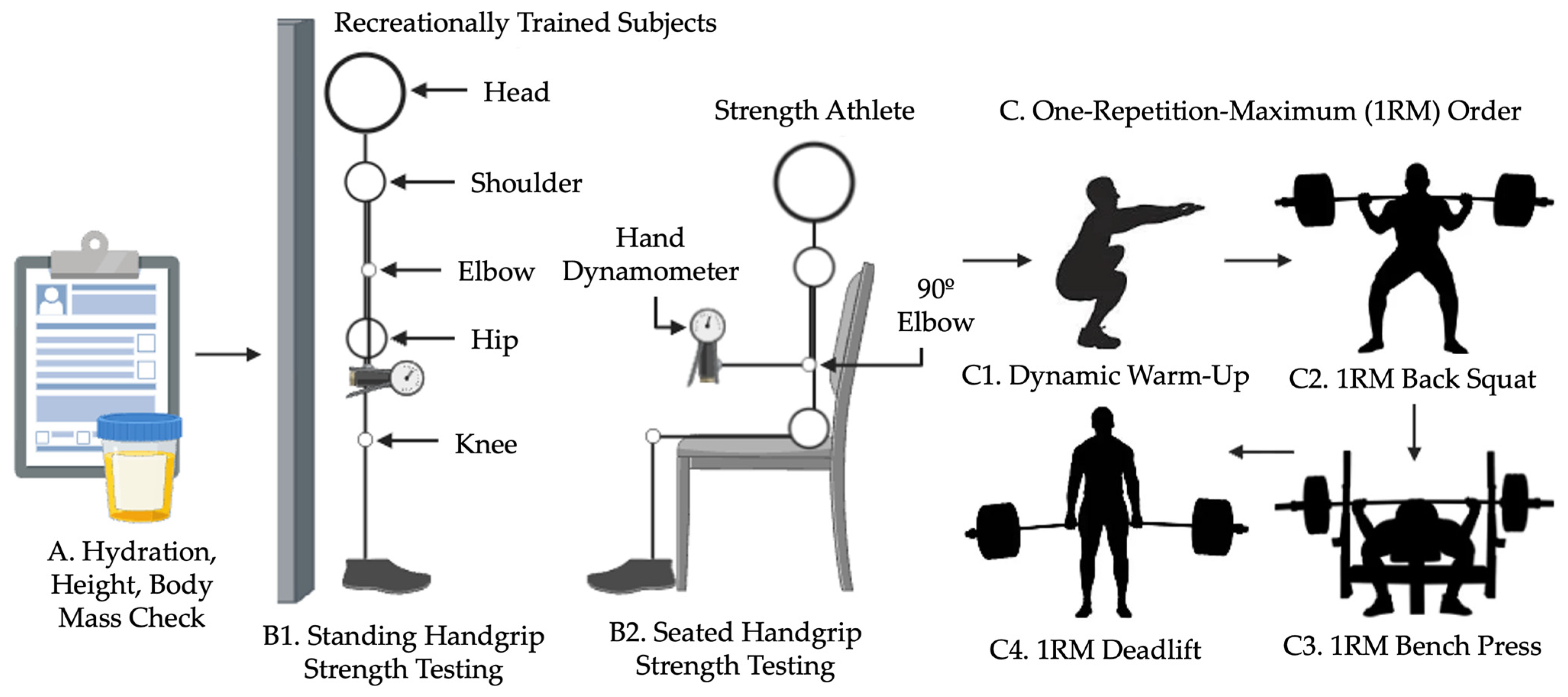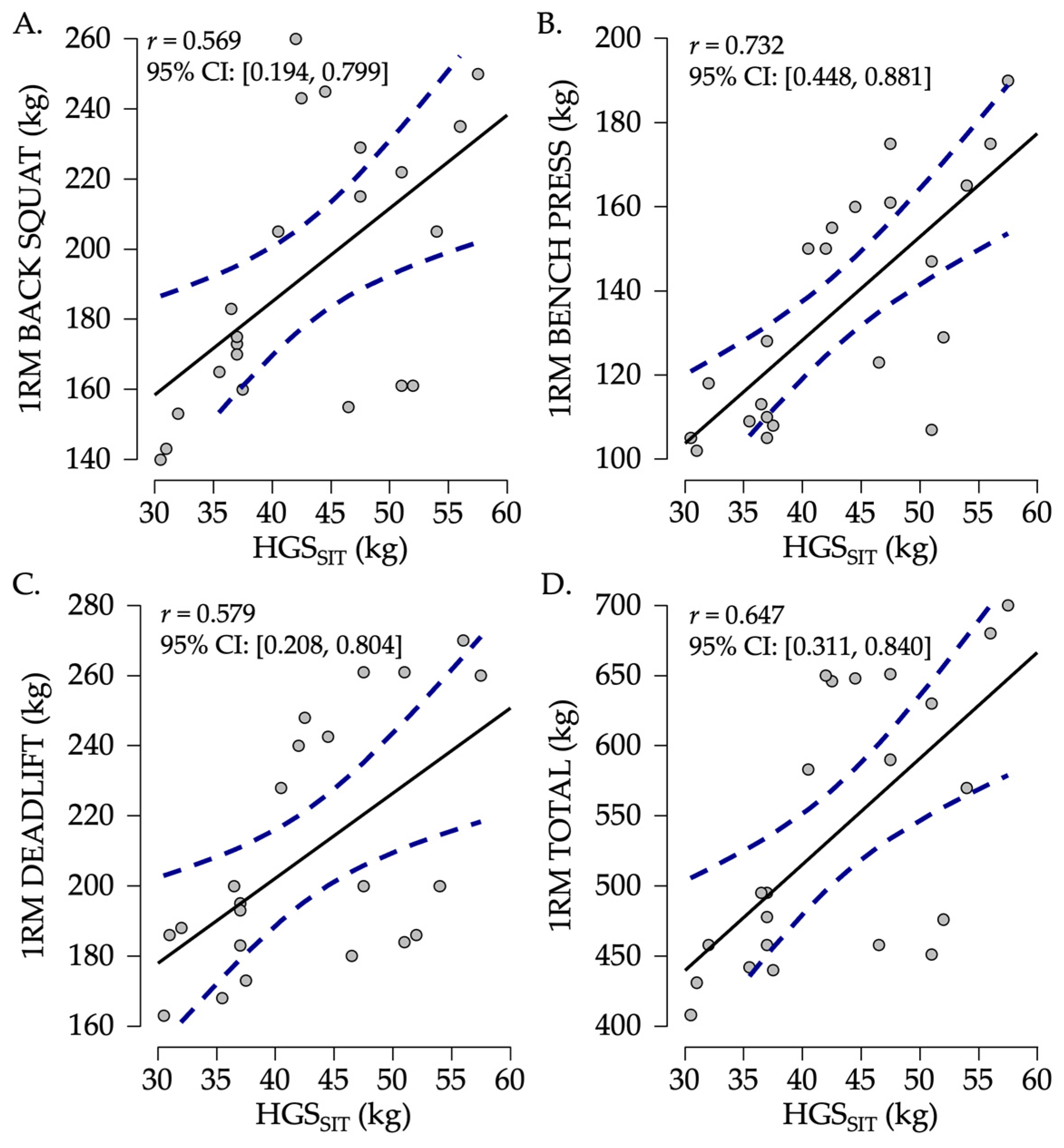Locked and Loaded: Divergent Handgrip Tests as Surrogate Measures for One-Repetition Maximal Strength
Abstract
1. Introduction
2. Materials and Methods
2.1. Study Participants
2.2. Testing Procedures
2.2.1. Hydration and Anthropometric Assessments
2.2.2. Standing Handgrip Strength Testing: Experiment 1—Recreationally Trained Subjects
2.2.3. Seated Handgrip Strength Testing: Experiment 2—Strength Athletes
2.2.4. One-Repetition Maximum Strength
2.3. Statistics
3. Results
3.1. Experiment 1: HGSSTAND—Recreationally Trained Subjects
3.1.1. Classical Correlations—HGSSTAND vs. Maximal Strength
3.1.2. Bayesian Correlations—HGSSTAND vs. Maximal Strength
3.2. Experiment 2: HGSSIT—Competitive Strength Athletes
3.2.1. Classical Correlations—HGSSIT vs. Maximal Strength
3.2.2. Bayesian Correlations—HGSSIT vs. Maximal Strength
3.3. Positional Handgrip Strength Comparisons and Maximal Strength Influence
4. Discussion
4.1. Standing Handgrip Strength and Deadlift Performance
4.2. Seated Handgrip Strength and Bench Press Performance
4.3. Postural Effects on Handgrip Strength (Between-Condition Comparisons)
4.4. General Strength and Grip Comparisons: Stronger vs. Weaker Individuals
4.5. Limitations
4.6. Practical Applications
5. Conclusions
Author Contributions
Funding
Institutional Review Board Statement
Informed Consent Statement
Data Availability Statement
Acknowledgments
Conflicts of Interest
References
- Cronin, J.; Lawton, T.; Harris, N.; Kilding, A.; McMaster, D.T. A Brief Review of Handgrip Strength and Sport Performance. J. Strength Cond. Res. 2017, 31, 3187–3217. [Google Scholar] [CrossRef] [PubMed]
- Labott, B.K.; Bucht, H.; Morat, M.; Morat, T.; Donath, L. Effects of Exercise Training on Handgrip Strength in Older Adults: A Meta-Analytical Review. Gerontology 2019, 65, 686–698. [Google Scholar] [CrossRef] [PubMed]
- Wang, D.X.M.; Yao, J.; Zirek, Y.; Reijnierse, E.M.; Maier, A.B. Muscle Mass, Strength, and Physical Performance Predicting Activities of Daily Living: A Meta-Analysis. J. Cachexia Sarcopenia Muscle 2020, 11, 3–25. [Google Scholar] [CrossRef]
- Abe, T.; Kohmura, Y.; Suzuki, K.; Someya, Y.; Loenneke, J.P.; Machida, S.; Naito, H. Athletes in Sporting Events with Upper-Body Gripping Movements Have Greater Handgrip Strength than Those in Sporting Events That Prioritize the Lower Body. Am. J. Hum. Biol. 2023, 35, e23891. [Google Scholar] [CrossRef] [PubMed]
- Sánchez-Pay, A.; Pino-Ortega, J.; Sanz-Rivas, D. Influence of Successive Wheelchair Tennis Matches on Handgrip Strength in High-Level Male Players. Int. J. Environ. Res. Public Health 2023, 20, 4842. [Google Scholar] [CrossRef]
- Ferraz, A.; Valente-Dos-Santos, J.; Duarte-Mendes, P.; Nunes, C.; Victorino, S.; Coelho-E-Silva, M.J.; Travassos, B. Body Composition and Grip Strength Constraints in Elite Male Rink-Hockey Players of Contrasting Ethnicity. PLoS ONE 2022, 17, e0274894. [Google Scholar] [CrossRef]
- Amato, A.; Giustino, V.; Patti, A.; Proia, P.; Trivic, T.; Drid, P.; Obradovic, A.; Manojlovic, M.; Mondoni, M.; Paoli, A.; et al. Young Basketball Players Have Better Manual Dexterity Performance than Sportsmen and Non-Sportsmen of the Same Age: A Cross-Sectional Study. Sci. Rep. 2023, 13, 20953. [Google Scholar] [CrossRef]
- Soylu, Ç.; Yıldırım, N.Ü.; Akalan, C.; Akınoğlu, B.; Kocahan, T. The Relationship Between Athletic Performance and Physiological Characteristics in Wheelchair Basketball Athletes. Res. Q. Exerc. Sport. 2021, 92, 639–650. [Google Scholar] [CrossRef]
- Camacho-Villa, M.A.; Hurtado-Alcoser, J.; Jerez, A.S.; Saavedra, J.C.; Paredes Prada, E.T.; Merchán, J.A.; Millan-Domingo, F.; Silva-Polanía, C.; De la Rosa, A. Handgrip Strength and Upper Limb Anthropometric Characteristics among Latin American Female Volleyball Players. J. Funct. Morphol. Kinesiol. 2024, 9, 168. [Google Scholar] [CrossRef]
- Francia, P.; Ferri Marini, C.; Bocchi, L.; Piccini, B.; Seghieri, G.; Federici, A.; Toni, S.; Lucertini, F. The Assessment of Ankle Range-of-Motion and Its Relationship with Overall Muscle Strength in a Cross-Section of Soccer Players. Sports 2023, 11, 12. [Google Scholar] [CrossRef]
- Burnett, P.J.M.; Willems, M.E.T. Effects of New Zealand Blackcurrant Extract on Sequential Performance Testing in Male Rugby Union Players. Sports 2022, 10, 152. [Google Scholar] [CrossRef] [PubMed]
- Stavrou, V.T.; Vavougios, G.D.; Tsirimona, G.; Daniil, Z.; Gourgoulianis, K.I. Sleep Quality in Greek Adolescent Swimmers. J. Funct. Morphol. Kinesiol. 2024, 9, 87. [Google Scholar] [CrossRef] [PubMed]
- Busta, J.; Hellebrand, J.; Kinkorová, I.; Duchoňová, A.; Hybská, T.; Sánchez, C.C.; Vajda, M. Body Morphology and Handgrip Strength Parameters of the Female Canoe Slalom Paddlers. Front. Physiol. 2024, 15, 1343341. [Google Scholar] [CrossRef] [PubMed]
- Stefan, R.R.; Camic, C.L.; Miles, G.F.; Kovacs, A.J.; Jagim, A.R.; Hill, C.M. Relative Contributions of Handgrip and Individual Finger Strength on Climbing Performance in a Bouldering Competition. Int. J. Sports Physiol. Perform. 2022, 17, 768–773. [Google Scholar] [CrossRef]
- Amaral, L.; Claessens, A.L.; Ferreirinha, J.E.; Santos, P.J. Ulnar Variance Related to Biological and Training Characteristics and Handgrip Strength in Portuguese Skeletally Immature Female Gymnasts. J. Sports Med. Phys. Fitness 2012, 52, 393–404. [Google Scholar]
- Karatrantou, K.; Katsoula, C.; Tsiakaras, N.; Ioakimidis, P.; Gerodimos, V. Strength Training Induces Greater Increase in Handgrip Strength than Wrestling Training per Se. Int. J. Sports Med. 2020, 41, 533–538. [Google Scholar] [CrossRef]
- Honorato, R.d.C.; Franchini, E.; Lara, J.P.R.; Fonteles, A.I.; Pinto, J.C.B.d.L.; Mortatti, A.L. Differences in Handgrip Strength-Endurance and Muscle Activation Between Young Male Judo Athletes and Untrained Individuals. Res. Q. Exerc. Sport 2021, 92, 1–10. [Google Scholar] [CrossRef]
- Folhes, O.; Reis, V.M.; Marques, D.L.; Neiva, H.P.; Marques, M.C. Maximum Isometric and Dynamic Strength of Mixed Martial Arts Athletes According to Weight Class and Competitive Level. Int. J. Environ. Res. Public Health 2022, 19, 8741. [Google Scholar] [CrossRef]
- Ince, İ.; Ulupinar, S. Prediction of Competition Performance via Selected Strength-Power Tests in Junior Weightlifters. J. Sports Med. Phys. Fitness 2020, 60, 236–243. [Google Scholar] [CrossRef]
- Guilherme, J.P.L.F.; Semenova, E.A.; Borisov, O.V.; Larin, A.K.; Moreland, E.; Generozov, E.V.; Ahmetov, I.I. Genomic Predictors of Testosterone Levels Are Associated with Muscle Fiber Size and Strength. Eur. J. Appl. Physiol. 2022, 122, 415–423. [Google Scholar] [CrossRef]
- Tromaras, K.; Zaras, N.; Stasinaki, A.-N.; Mpampoulis, T.; Terzis, G. Lean Body Mass, Muscle Architecture and Powerlifting Performance during Preseason and in Competition. J. Funct. Morphol. Kinesiol. 2024, 9, 89. [Google Scholar] [CrossRef] [PubMed]
- Travis, S.K.; Mujika, I.; Gentles, J.A.; Stone, M.H.; Bazyler, C.D. Tapering and Peaking Maximal Strength for Powerlifting Performance: A Review. Sports 2020, 8, 125. [Google Scholar] [CrossRef] [PubMed]
- Travis, S.K.; Mujika, I.; Zwetsloot, K.A.; Gentles, J.A.; Stone, M.H.; Bazyler, C.D. The Effects of 3 vs. 5 Days of Training Cessation on Maximal Strength. J. Strength Cond. Res. 2022, 36, 633–640. [Google Scholar] [CrossRef]
- Drid, P.; Casals, C.; Mekic, A.; Radjo, I.; Stojanovic, M.; Ostojic, S.M. Fitness and Anthropometric Profiles of International vs. National Judo Medalists in Half-Heavyweight Category. J. Strength Cond. Res. 2015, 29, 2115–2121. [Google Scholar] [CrossRef]
- Jukic, I.; García-Ramos, A.; Baláš, J.; Malecek, J.; Omcirk, D.; Tufano, J.J. Ergogenic Effects of Lifting Straps on Movement Velocity, Grip Strength, Perceived Exertion and Grip Security during the Deadlift Exercise. Physiol. Behav. 2021, 229, 113283. [Google Scholar] [CrossRef]
- Schiemann, S.; Keiner, M.; Wirth, K.; Lohmann, L.H.; Wagner, C.-M.; Behm, D.G.; Warneke, K. The Magnitude of Correlation between Deadlift 1RM and Jumping Performance Is Sports Dependent. Front. Sports Act. Living 2024, 6, 1345213. [Google Scholar] [CrossRef] [PubMed]
- Travis, S.K.; Zourdos, M.C.; Bazyler, C.D. Weight Selection Attempts of Elite Classic Powerlifters. Percept. Mot. Skills 2021, 128, 507–521. [Google Scholar] [CrossRef]
- Schoffstall, J.E.; Morrison, S.; Boswell, B.; Kozlik, B. Grip Strength and Powerlifting Performance. In Proceedings of the Southeastern Chapter of the American College of Sports Medicine Regional Conference, Greenville, SC, USA, February 2010. [Google Scholar]
- Suazo, N.; Debeliso, M. The Relationship between Powerlifting Performance and Hand Grip Strength among Female Athletes. Turk. J. Kinesiol. 2021, 7, 112–122. [Google Scholar] [CrossRef]
- Balogun, J.A.; Akomolafe, C.T.; Amusa, L.O. Grip Strength: Effects of Testing Posture and Elbow Position. Arch. Phys. Med. Rehabil. 1991, 72, 280–283. [Google Scholar]
- Kompf, J.; Arandjelović, O. The Sticking Point in the Bench Press, the Squat, and the Deadlift: Similarities and Differences, and Their Significance for Research and Practice. Sports Med. 2017, 47, 631–640. [Google Scholar] [CrossRef]
- Boadella, J.M.; Kuijer, P.P.; Sluiter, J.K.; Frings-Dresen, M.H. Effect of Self-Selected Handgrip Position on Maximal Handgrip Strength. Arch. Phys. Med. Rehabil. 2005, 86, 328–331. [Google Scholar] [CrossRef] [PubMed]
- Keener, M.M.; Tumlin, K.I.; Heebner, N.R. Combined Driving: Task-Specific Position Impacts Grip Strength of Equestrian Athletes. Eur. Rev. Aging Phys. Act. 2022, 19, 2. [Google Scholar] [CrossRef] [PubMed]
- Vaishya, R.; Misra, A.; Vaish, A.; Ursino, N.; D’Ambrosi, R. Hand Grip Strength as a Proposed New Vital Sign of Health: A Narrative Review of Evidences. J. Health Popul. Nutr. 2024, 43, 7. [Google Scholar] [CrossRef]
- van den Hoek, D.J.; Beaumont, P.L.; van den Hoek, A.K.; Owen, P.J.; Garrett, J.M.; Buhmann, R.; Latella, C. Normative Data for the Squat, Bench Press and Deadlift Exercises in Powerlifting: Data from 809,986 Competition Entries. J. Sci. Med. Sport 2024, 27, 734–742. [Google Scholar] [CrossRef] [PubMed]
- van den Hoek, D.; Garrett, J.; Travis, S.K.; Oxnard, K.; Howells, R.; Owen, P.; Latella, C. Analysis of Competition Performance Leading to Success at the International Powerlifting Federation World Championships Between 2013 and 2019. J. Strength Cond. Res. 2023, 37, e555. [Google Scholar] [CrossRef]
- USA Powerlifting. USA Powerlifting Technical Rules 2024, Version 2024.1; USA Powerlifting: Anchorage, AK, USA, 2024. [Google Scholar]
- Travis, S.K.; Zwetsloot, K.A.; Mujika, I.; Stone, M.H.; Bazyler, C.D. Skeletal Muscle Adaptations and Performance Outcomes Following a Step and Exponential Taper in Strength Athletes. Front. Physiol. 2021, 12, 1766. [Google Scholar] [CrossRef]
- Burke, B.I.; Carroll, K.M.; Travis, S.K.; Stone, M.E.; Stone, M.H. Two Days Versus Four Days of Training Cessation Following a Step-Taper in Powerlifters. J. Strength Cond. Res. 2023, 37, 625–632. [Google Scholar] [CrossRef]
- Burke, B.I.; Travis, S.K.; Gentles, J.A.; Sato, K.; Lang, H.M.; Bazyler, C.D. The Effects of Caffeine on Jumping Performance and Maximal Strength in Female Collegiate Athletes. Nutrients 2021, 13, 2496. [Google Scholar] [CrossRef]
- Parvatikar, V.B.; Mukkannavar, P.B. Comparative Study of Grip Strength in Different Positions of Shoulder and Elbow with Wrist in Neutral and Extension Positions. J. Ex. Sci. Physiother. 2011, 5, 67–75. [Google Scholar]
- España-Romero, V.; Ortega, F.B.; Vicente-Rodríguez, G.; Artero, E.G.; Rey, J.P.; Ruiz, J.R. Elbow Position Affects Handgrip Strength in Adolescents: Validity and Reliability of Jamar, DynEx, and TKK Dynamometers. J. Strength Cond. Res. 2010, 24, 272–277. [Google Scholar] [CrossRef]
- Jamar®. Jamar® Hydraulic Hand Dynamometer Owner’s Manual; Performance Health: Warrenville, IL, USA, 2024. [Google Scholar]
- Vanderburgh, P.M.; Batterham, A.M. Validation of the Wilks Powerlifting Formula. Med. Sci. Sports Exerc. 1999, 31, 1869–1875. [Google Scholar] [CrossRef]
- Hopkins, W.G. New View of Statistics: Effect Magnitudes. Available online: https://www.sportsci.org/resource/stats/effectmag.html (accessed on 29 January 2025).
- Jeffreys, H. The Theory of Probablity; Oxford University Press: Oxford, UK, 1939. [Google Scholar]
- Choe, K.H.; Coburn, J.W.; Costa, P.B.; Pamukoff, D.N. Hip and Knee Kinetics During a Back Squat and Deadlift. J. Strength Cond. Res. 2021, 35, 1364–1371. [Google Scholar] [CrossRef] [PubMed]
- Cholewa, J.M.; Atalag, O.; Zinchenko, A.; Johnson, K.; Henselmans, M. Anthropometrical Determinants of Deadlift Variant Performance. J. Sports Sci. Med. 2019, 18, 448–453. [Google Scholar] [PubMed]
- Martín-Fuentes, I.; Oliva-Lozano, J.M.; Muyor, J.M. Electromyographic Activity in Deadlift Exercise and Its Variants. A Systematic Review. PLoS ONE 2020, 15, e0229507. [Google Scholar] [CrossRef]
- García-Hermoso, A.; Cavero-Redondo, I.; Ramírez-Vélez, R.; Ruiz, J.R.; Ortega, F.B.; Lee, D.-C.; Martínez-Vizcaíno, V. Muscular Strength as a Predictor of All-Cause Mortality in an Apparently Healthy Population: A Systematic Review and Meta-Analysis of Data from Approximately 2 Million Men and Women. Arch. Phys. Med. Rehabil. 2018, 99, 2100–2113.e5. [Google Scholar] [CrossRef] [PubMed]
- Stastny, P.; Gołaś, A.; Blazek, D.; Maszczyk, A.; Wilk, M.; Pietraszewski, P.; Petr, M.; Uhlir, P.; Zając, A. A Systematic Review of Surface Electromyography Analyses of the Bench Press Movement Task. PLoS ONE 2017, 12, e0171632. [Google Scholar] [CrossRef]
- Nikolaidis, P.T.; Papaioannou, K.-G.; Rosemann, T.; Knechtle, B. Exercise Testing of Muscle Strength in Military. Mil. Med. 2019, 184, e426–e430. [Google Scholar] [CrossRef]
- Núñez-Cortés, R.; Cruz, B.D.P.; Gallardo-Gómez, D.; Calatayud, J.; Cruz-Montecinos, C.; López-Gil, J.F.; López-Bueno, R. Handgrip Strength Measurement Protocols for All-Cause and Cause-Specific Mortality Outcomes in More than 3 Million Participants: A Systematic Review and Meta-Regression Analysis. Clin. Nutr. 2022, 41, 2473–2489. [Google Scholar] [CrossRef]
- Vargas-Pinilla, O.-C.; Rodríguez-Grande, E.-I. Reproducibility and Agreement between Three Positions for Handgrip Assessment. Sci. Rep. 2021, 11, 12906. [Google Scholar] [CrossRef]
- Almashaqbeh, S.F.; Al-Momani, S.; Khader, A.; Qananwah, Q.; Marabeh, S.; Maabreh, R.; Al Badarneh, A.; Abdullah, K. The Effect of Gender and Arm Anatomical Position on the Hand Grip Strength and Fatigue Resistance during Sustained Maximal Handgrip Effort. J. Biomed. Phys. Eng. 2022, 12, 171–180. [Google Scholar] [CrossRef]
- Shyam Kumar, A.J.; Parmar, V.; Ahmed, S.; Kar, S.; Harper, W.M. A Study of Grip Endurance and Strengh in Different Elbow Positions. J. Orthop. Traumatol. 2008, 9, 209–211. [Google Scholar] [CrossRef] [PubMed]
- Harris, D.M.; Kendall, K.; Haff, G.G.; Latella, C. Absolute and Relative Strength, Power and Physiological Characteristics of Indian Junior National-Level Judokas. Sports 2020, 8, 14. [Google Scholar] [CrossRef] [PubMed]
- Melnychuk, I.M.; Yastremska, S.O.; Popovych, D.V.; Humeniuk, V.V.; Yefremova, O.V.; Novakova, L.V.; Shukatka, O.V. Health Dynamics of the Medical University Students During Sports Activities. Wiad. Lek. 2021, 74, 295–302. [Google Scholar] [CrossRef] [PubMed]
- Sun, R.; Wan, J.; Tang, J.; Deng, Y.; Zhang, M.; Liu, C.; Li, J.; Zhang, Q. Effectiveness of Resistance Training on Body Composition, Muscle Strength, and Biomarker in Sarcopenic Older Adults: A Meta-Analysis of Randomized Controlled Trials. Arch. Gerontol. Geriatr. 2025, 128, 105595. [Google Scholar] [CrossRef]




| Classical Correlation | HGSSTAND vs. | r | p | 95% CI1 | Hopkins’ Classification |
| 1RM BS | 0.649 | 0.001 | [0.313, 0.841] | Large | |
| 1RM BP | 0.557 | 0.007 | [0.177, 0.792] | Large | |
| 1RM DL | 0.693 | <0.001 | [0.384, 0.863] | Large | |
| 1RM TOT | 0.672 | <0.001 | [0.313, 0.837] | Large | |
| Bayesian Correlation | HGSSTAND vs. | r | BF10 | 95% CI2 | Jeffreys’ Classification |
| 1RM BS | 0.649 | 39.32 | [0.279, 0.824] | Very Strong | |
| 1RM BP | 0.557 | 7.95 | [0.154, 0.772] | Moderate | |
| 1RM DL | 0.693 | 106.42 | [0.346, 0.849] | Extreme | |
| 1RM TOT | 0.672 | 63.97 | [0.313, 0.837] | Very Strong |
| Classical Correlation | HGSSIT vs. | r | p | 95% CI1 | Hopkins’ Classification |
| 1RM BS | 0.569 | 0.006 | [0.194, 0.799] | Large | |
| 1RM BP | 0.732 | <0.001 | [0.448, 0.881] | Very Large | |
| 1RM DL | 0.579 | 0.005 | [0.208, 0.804] | Large | |
| 1RM TOT | 0.647 | 0.001 | [0.311, 0.840] | Large | |
| Bayesian Correlation | HGSSIT vs. | r | BF10 | 95% CI2 | Jeffreys’ Classification |
| 1RM BS | 0.569 | 9.49 | [0.169, 0.779] | Moderate | |
| 1RM BP | 0.732 | 291.32 | [0.407, 0.870] | Extreme | |
| 1RM DL | 0.579 | 11.10 | [0.182, 0.784] | Strong | |
| 1RM TOT | 0.647 | 38.15 | [0.277, 0.823] | Very Strong |
Disclaimer/Publisher’s Note: The statements, opinions and data contained in all publications are solely those of the individual author(s) and contributor(s) and not of MDPI and/or the editor(s). MDPI and/or the editor(s) disclaim responsibility for any injury to people or property resulting from any ideas, methods, instructions or products referred to in the content. |
© 2025 by the authors. Licensee MDPI, Basel, Switzerland. This article is an open access article distributed under the terms and conditions of the Creative Commons Attribution (CC BY) license (https://creativecommons.org/licenses/by/4.0/).
Share and Cite
Travis, S.K.; Schwarz, A.V.; Burke, B.I. Locked and Loaded: Divergent Handgrip Tests as Surrogate Measures for One-Repetition Maximal Strength. Biomechanics 2025, 5, 16. https://doi.org/10.3390/biomechanics5010016
Travis SK, Schwarz AV, Burke BI. Locked and Loaded: Divergent Handgrip Tests as Surrogate Measures for One-Repetition Maximal Strength. Biomechanics. 2025; 5(1):16. https://doi.org/10.3390/biomechanics5010016
Chicago/Turabian StyleTravis, S. Kyle, Antonella V. Schwarz, and Benjamin I. Burke. 2025. "Locked and Loaded: Divergent Handgrip Tests as Surrogate Measures for One-Repetition Maximal Strength" Biomechanics 5, no. 1: 16. https://doi.org/10.3390/biomechanics5010016
APA StyleTravis, S. K., Schwarz, A. V., & Burke, B. I. (2025). Locked and Loaded: Divergent Handgrip Tests as Surrogate Measures for One-Repetition Maximal Strength. Biomechanics, 5(1), 16. https://doi.org/10.3390/biomechanics5010016







